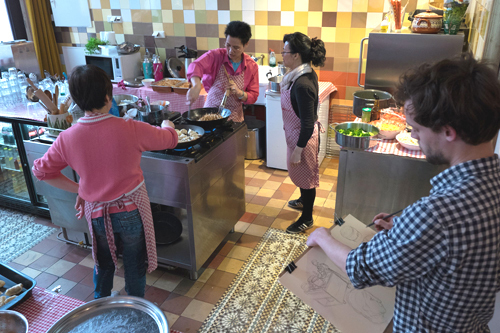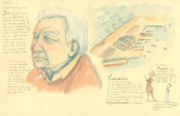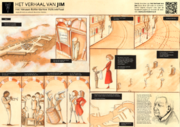Difference between revisions of "The New Rotterdam Folk Story"
| Line 3: | Line 3: | ||
Actually, modern society is supersaturated with stories. You might not even realise it, but nowadays we are confronted with storytelling almost every minute. Most of us are connected 24/7 to media like Facebook, Twitter, Whatsapp, Skype, Instagram and a variety of news-feeds. And how many times a day are you confronted with adverts? Now most of these “stories” would make lousy bedtime stories, but they are stories nonetheless. So what’s the point of storytelling? And how could designers and fine-artists make use of them in this modern, supersaturated society? | Actually, modern society is supersaturated with stories. You might not even realise it, but nowadays we are confronted with storytelling almost every minute. Most of us are connected 24/7 to media like Facebook, Twitter, Whatsapp, Skype, Instagram and a variety of news-feeds. And how many times a day are you confronted with adverts? Now most of these “stories” would make lousy bedtime stories, but they are stories nonetheless. So what’s the point of storytelling? And how could designers and fine-artists make use of them in this modern, supersaturated society? | ||
| − | + | ==== The power of representation ==== | |
Storytelling is as old as the human species. In his book “On The Origins of Stories” (2010) literary expert Brian Boyd describes how telling stories made prehistoric humans different from its apelike-cousins. The human species are considered to have survived the long and dangerous evolutionary path from apes to cognitive beings by becoming magnificently social animals. We developed skills to hunt and scavenge in groups, to establish hierarchies and to express our feelings. But the secret weapon of our social skill-pack, that what makes us human, is our instinctive power to understand and construct representation. Ancient cave paintings from the Ice Age are well-known examples of an early human urge to express ideas about their surroundings and their place in it, by granting certain collective values and concepts to objects and two-dimensional shapes. Boyd argues that humans are uniquely evolved to communicate through representation, in language and in pictures. In other words: humans communicate through storytelling. | Storytelling is as old as the human species. In his book “On The Origins of Stories” (2010) literary expert Brian Boyd describes how telling stories made prehistoric humans different from its apelike-cousins. The human species are considered to have survived the long and dangerous evolutionary path from apes to cognitive beings by becoming magnificently social animals. We developed skills to hunt and scavenge in groups, to establish hierarchies and to express our feelings. But the secret weapon of our social skill-pack, that what makes us human, is our instinctive power to understand and construct representation. Ancient cave paintings from the Ice Age are well-known examples of an early human urge to express ideas about their surroundings and their place in it, by granting certain collective values and concepts to objects and two-dimensional shapes. Boyd argues that humans are uniquely evolved to communicate through representation, in language and in pictures. In other words: humans communicate through storytelling. | ||
| Line 18: | Line 18: | ||
In my opinion, our more complicated societies nowadays need designers and fine-artists more than ever for this social engagement. In my essay and graduation-project The New Rotterdam Folk Story (dutch: Het Nieuwe Rotterdamse Volksverhaal) I describe the culturally diverse city of Rotterdam as an Archipelago City, a city consisting of many cultural and ethnic islands that participate in the same society but almost never mix. Moreover, the harder politics try to create a homogenous society, the more these islands tend to isolate themselves. The Archipel City is defined by its diversity. As an illustrator interested in stories I saw the opportunity to occupy a unique position in between these social islands, and to visualise the stories of individuals from different groups in society. By doing this, I created an interesting collection of visualised personal stories, available for a bigger Rotterdam audience. | In my opinion, our more complicated societies nowadays need designers and fine-artists more than ever for this social engagement. In my essay and graduation-project The New Rotterdam Folk Story (dutch: Het Nieuwe Rotterdamse Volksverhaal) I describe the culturally diverse city of Rotterdam as an Archipelago City, a city consisting of many cultural and ethnic islands that participate in the same society but almost never mix. Moreover, the harder politics try to create a homogenous society, the more these islands tend to isolate themselves. The Archipel City is defined by its diversity. As an illustrator interested in stories I saw the opportunity to occupy a unique position in between these social islands, and to visualise the stories of individuals from different groups in society. By doing this, I created an interesting collection of visualised personal stories, available for a bigger Rotterdam audience. | ||
| − | + | ==== Reclaiming pictorial journalism with illustration ==== | |
[[File:hnrv4.png|A portrait of a Rotterdammer]] | [[File:hnrv4.png|A portrait of a Rotterdammer]] | ||
Revision as of 16:32, 21 June 2015
Especially with the coming of modern technology and media like mobile phones many at the beginning of the twenty-first century argued that “the story is dead” in western society. True, books are being read less and less, and fewer children and teenagers have the concentration to read texts or listen to someone for longer than 30 minutes. And tribes with their oral traditions are almost entirely extinct. But do not despair; the story is long but dead.
Actually, modern society is supersaturated with stories. You might not even realise it, but nowadays we are confronted with storytelling almost every minute. Most of us are connected 24/7 to media like Facebook, Twitter, Whatsapp, Skype, Instagram and a variety of news-feeds. And how many times a day are you confronted with adverts? Now most of these “stories” would make lousy bedtime stories, but they are stories nonetheless. So what’s the point of storytelling? And how could designers and fine-artists make use of them in this modern, supersaturated society?
The power of representation
Storytelling is as old as the human species. In his book “On The Origins of Stories” (2010) literary expert Brian Boyd describes how telling stories made prehistoric humans different from its apelike-cousins. The human species are considered to have survived the long and dangerous evolutionary path from apes to cognitive beings by becoming magnificently social animals. We developed skills to hunt and scavenge in groups, to establish hierarchies and to express our feelings. But the secret weapon of our social skill-pack, that what makes us human, is our instinctive power to understand and construct representation. Ancient cave paintings from the Ice Age are well-known examples of an early human urge to express ideas about their surroundings and their place in it, by granting certain collective values and concepts to objects and two-dimensional shapes. Boyd argues that humans are uniquely evolved to communicate through representation, in language and in pictures. In other words: humans communicate through storytelling.
Not only do we tell stories, humans are even better in recognising them. In a 1944 experiment, Fritz Heider and Marianne Simmel showed students a simple silent film, and asked them to write down afterwards what they had seen. The film consisted only of two triangular shapes and one circle moving about the screen around a partially opened rectangle. Yet, instead of describing the factual movement of geometric shapes, all of the students except one came up with elaborate storylines. Look up the experiment and see what you come up with yourself.
Whether we want it or not, we see stories even in places where none was explicitly intended in the first place, especially in images. Images grant a more direct way of experiencing a story than texts do. We interpret and understand their meaning almost instantaneously. Take for instance the popularity of visual storytelling media like movies, television, documentaries, but also online role-playing games, advertisements and Instagram. This makes me believe that the best way to convey stories is trough pictures, because the audience automatically searches for story in them. This has already given designers and fine-artists lots of opportunities to bring their artwork closer to society, and even to engage with society through their art.
The New Rotterdam Folk Story
In my opinion, our more complicated societies nowadays need designers and fine-artists more than ever for this social engagement. In my essay and graduation-project The New Rotterdam Folk Story (dutch: Het Nieuwe Rotterdamse Volksverhaal) I describe the culturally diverse city of Rotterdam as an Archipelago City, a city consisting of many cultural and ethnic islands that participate in the same society but almost never mix. Moreover, the harder politics try to create a homogenous society, the more these islands tend to isolate themselves. The Archipel City is defined by its diversity. As an illustrator interested in stories I saw the opportunity to occupy a unique position in between these social islands, and to visualise the stories of individuals from different groups in society. By doing this, I created an interesting collection of visualised personal stories, available for a bigger Rotterdam audience.
Reclaiming pictorial journalism with illustration
I collected these stories by drawing a portrait of the individual, or individuals. I did not use a recording device or camera. The making of such a portrait gave me around 20 minutes of quality time with the participant, creating a relaxed and intimate atmosphere that would have been very different if I used a film of photo camera, because these media are considered very direct. Cameras tend to create a distance between artist and subject, where drawing needs a connection with the subject that is more intimate, and therefore creates a visualisation that possesses and communicates more feeling. With drawings, the viewer experiences not only the representation of the drawing itself, but also the process of making it. We are so used to cameras around us that I believe that photographs tend to lose this experience.
This effect is also felt in the world of journalism. Nowadays, illustrators are reclaiming a place in pictorial reportage and journalism, which has almost entirely been taken from them by photography in the early twentieth century. Illustrators are now joining journalists in conflict areas to visualise their experiences, or investigating and visualising politics and economy.
In The New Rotterdam Folk Story, I used the portraits as a base for short Graphic Novels, which in turn I made into short video-clips. This way, I made use of two very recognisable and popular storytelling-media. Also, I knew that these visual translations would be more suitable for sharing in magazines and online. Look at the stories by searching HNRV in vimeo.
id=8758454
The New Rotterdam Folk Story will be shown in Het Verhalenhuis Belvédère, Rotterdam in late summer 2015. Keep up to date by following the facebook-page of “Het Nieuwe Rotterdamse Volksverhaal”.
Aron Dijkstra


